#powered by the apocalypse
Text
Pictures that make a "the only TTRPG I know is D&D"-person spontaneously combust:

This is the entirety of the magic mechanics in the game "Interstitial: Our Hearts Intertwined"
I'm keeping this post for the next time I hear someone say they don't want to try a new game because it's too hard to learn a new system.
#d&d#dnd#dungeons & dragons#dungeons and dragons#ttrpg#tabletop rpg#pbta#powered by the apocalypse#interstitial our hearts intertwined#interstitial
781 notes
·
View notes
Text
Why I Dislike PbtA Games, and How Eureka: Investigative Urban Fantasy is Their Opposite

@tender-curiosities

It is no secret that I hate PbtA games.
Though due to a recent misunderstanding regarding another post, I’m going to preface this post by saying that this is going to be a very opinionated post and
I do not seriously think that PbtA games are inherently bad, though I may sometimes joke about this.
While I do often question the taste of people who make and play PbtA hacks, I do not think poorly of their moral character.
While I am going to call for PbtA to be used less as a base for games in the future, I’m not saying that the whole system and all games based on it should be destructified. It’s good for what it’s good for, but unless you’re doing that, I really think you should use something else.
Now that that is out of the way, here’s what I have to say about it.
My first experiences with PbtA games were pretty rough. Monster of the Week was not the first, but it was one of the first ‘indie’ TTRPGs I played after having previously played mostly only D&D3.5e and 5e. I really appreciated that the use of 2D6 over a D20 meant that the dice results would be more predictable, and I really liked the various “classes” I was seeing. (At this time, I didn’t really understand that they weren’t really “classes” at all, though I think I can be forgiven for this because many people, even people who like PbtA games, still talk like “classes” and “playbooks” are interchangeable.)
I was very enthusiastic to play, until it came time to start actually “making” a character, and found that I couldn’t “make” a character. I wanted to make a nuanced, three-dimensional PC who was simultaneously stereotype-affirming and stereotype-defying, with a unique backstory and dynamic with the other characters—but when I went to actually fill out the character sheet for basically any “class”, I found that most of the backstory and most of the personality for my character was being set for me by the playbook. It felt like the only thing about the character I really had a say in was their name, and that two PCs of the same playbook would actually turn out to be almost identical characters. At the time, I thought this was very restrictive and very bad design.
Later, now that I understand the design intent behind it, I still think of it as very restrictive, but I think of it as very bad design for me, not inherently bad.
When I play a TTRPG, I want more freedom in who my PC is. That doesn’t mean I want less rules, in fact having more rules can often increase freedom, but that’s a different post. I want to create original, unique characters, that I won’t see anywhere else. If it’s a class-based system, I want that class to barely touch the details of my character’s backstory or personality, so that I can come up with something original and engaging for why and how this “Fighter” fights. This means that two level-1 Fighters, despite having almost the same mechanical abilities, will potentially be very different people.
PbtA games don’t let you do that. In a lot of PbtA games, you’re not playing your own original character, you’re playing someone else’s character, that every other player that has picked up the same playbook before you has played. It’s more like “character select” than “character creation.” I think I could liken it to playing Mass Effect or The Witcher. Every player may pick a few different dialogue choices in those games that change the story, but we’re still all playing Shepherd or Geralt. No one is going to experience a new never-before-seen story in Mass Effect or The Witcher, which is very much a factor of them being video games and not TTRPGs, and therefore limited to the amount of code, writing, and voice-acting that can go into them.
This anonymous asker who sent a message to @thydungeongal seems to feel pretty similarly to me about PbtA games, and @thydungeongal's response is a very good response about how people find this appealing.
I have more respect for PbtA now than I did, but I still don't like it because to me it seems to play so much against what I consider to be the strengths of TTRPGs as a medium, much like how video games like The Last of Us and David Cage games play against the strengths of the medium of video games, and I will never like it. But other people clearly do, so to each their own.
Then another reason I don’t like it is because I think it’s oversaturating the TTRPG space. I’ve referred to PbtA before as “indie D&D5e”, and i do think that’s a reasonable comparison, because in much the same way that you always hear “D&D5e is a system that can do everything”, I think a lot of people seem to be under the impression that the PbtA system is a system that can do anything. It’s kinda the système du jour for indie TTRPGs right now, and many iterations of it make it clear that many designers do not consider how PbtA differs from more traditional TTRPGs, and how it is specialized for different types of TTRPG gameplay. Just like how I feel PbtA isn’t playing to certain important strengths of TTRPGs, I think that many—maybe even most—PbtA hacks don’t play to the strengths of PbtA. But this isn’t really PbtA’s fault, that comes down to any individual indie TTRPG developer on a case-by-case basis. And the cure for that is something I’m always saying: If you are going to be a writer, you have got to read lots of books. If you are going to be a director, you have got to watch lots of movies. If you are going to be a video game developer, you have got to play lots of video games. And if you are going to be a TTRPG designer, you have got to read and play lots of TTRPGs. That and you have to understand that TTRPGs are specialized. Even "agnostic" systems like PbtA are somewhat specialized, and therefore might really not be a great fit for the game you’re trying to make.
That and, to get more subjective again, there’s like an ocean of them, and I don’t even like the ones that are actually good.

Now that I’ve talked about how I don’t like PbtA games, I’m gonna talk about a game I do like: Eureka: Investigative Urban Fantasy. Obviously, I like it because I’m the lead writer for it, but I would also like it even if I wasn’t the lead writer for it, because it’s just my kinda game. Eureka is the opposite of a PbtA game. I wrote it to play to what I feel are the strengths of the TTRPG medium.
Eureka’s character creation uses personality traits as a mechanical element of the character, but it does so in a deliberately freeform way. You build your character’s personality out of a list of traits, so who your character is is very much linked to what your character can do, but we aren’t just handing you a pre-made character.
Eureka is designed to incentivize organic decision-making by the PCs, most often by the mechanics of the game mirroring the world they live in. Every mechanic aims to create situations wherein “what will the PC do next?” is a question whose answer can be predicted - it doesn’t need to be ordained by a playbook.
One of my favorite examples of this is, rather than a “Fear Check” forcing the PC to run away if they fail, or “Run Away from Danger” being a “Move” on their character sheet, Eureka opts for the Composure mechanic. The really short version is that one of the main things that lowers a PC’s Composure is encountering scary stuff, and the lower a PC’s Composure, the more likely they are to fail skill checks, and the more likely they are to fail skill checks, well, the less brave they and their player probably feel about them standing up to this scary monster. So if the PC has low Composure, they are more likely to choose to run away. The lower their Composure, the better idea that will seem.
This system really really shines when it comes to monster PCs in Eureka. Most monsters benefit a lot more from having high Composure, but have fewer ways to restore Composure than mundane PCs. Their main way to restore their Composure is by eating people. The rulebook never says “your monster PC has to eat people”, but more likely than not, they’re going to be organically steered towards that by the game and world itself. Sure, they could decide to be “one of the good ones”, and just never eat people, just like you reading this could decide to stop eating food. You technically could, but when your body starts to fail, how long would you? (This is a big part of the themes of Eureka and what it has to say about crime, disability, mental illness, and evil. People don’t just arbitrarily do bad things, it is often their circumstances that leads them down that path until they see little choice for themselves in that matter, and “harmful” people are still just as deserving of life as people who “aren’t harmful”, but that really deserves its own post.)
It has been said that Eureka: Investigative Urban Fantasy actually arrives at much the same end as the PbtA game Monsterhearts, and I actually don’t disagree, but it gets there from an entirely different starting point and direction. The monster PCs in Eureka are very likely to eat people and cause drama, but it won’t be because they have “Eat People and Cause Drama” as a “Move” on their character sheet.
Monsters in Eureka have a lot of abilities, which they can use to solve (and create) problems as the emergent story emerges organically.
(Oh and Eureka is about adult investigators investigating mysteries, and sometimes those investigators are monsters, not about monster kids in high school, to be clear. The same “end” that Eureka and Monsterhearts reach is that of the monsters being prone to cause problems and drama due to the fact that they are monsters, though this isn’t the sole point of Eureka, just one element of it.)
You can pick up the free shareware version of this game from the download link on our website, or the full version for $5 from our Patreon.
And don’t forget, Eureka is fundraising on Kickstarter starting on April 10th, 2024! We need your support there most of all, to make sure we hit our goals and can afford to make the best version of Eureka we can make!
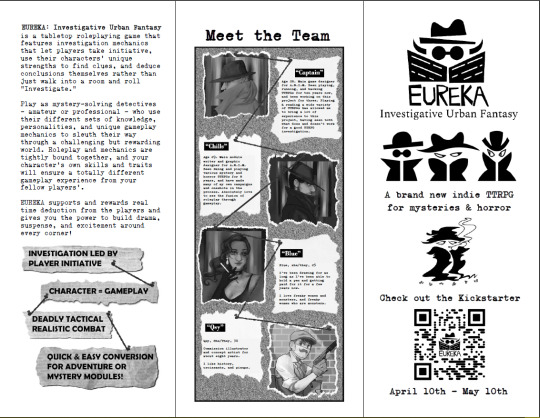
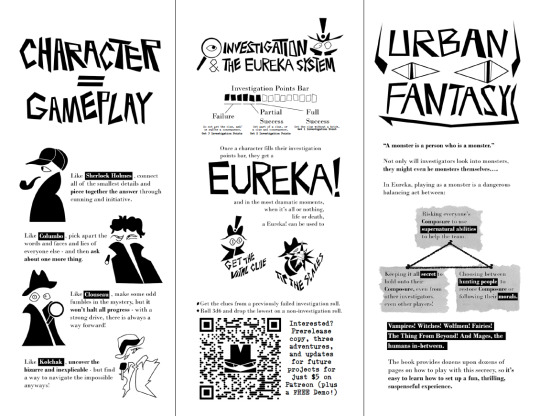
Interested in branching out but can’t get your group to play anything but D&D5e? Join us at the A.N.I.M. TTRPG Book Club, where we nominate, vote on, and play indie TTRPGs, all organized by our team with no strict schedule requirement! Here's the invite link! See you there!
We also have merchandise.

#eureka: investigative urban fantasy#ttrpg#rpg#roleplaying#eureka#tabletop#monsters#coc#allied forces#monsterhearts#pbta#powered by the apocalypse#motw#monster of the week#motw ttrpg#motw character#d&d 5e#d&d#dungeons and dragons#dnd#dnd5e#d&d5e#fighter#indie#indiegames#indie game#indie games#indie designer#ttrpg design#ttrpg community
202 notes
·
View notes
Text
Have you played MASKS : A New Generation ?
By Brendan Conway

Young superheroes grow into their powers and the paragons they will one day become, while grappling with villains, adult pro heroes, and the tribulations of young adult life.
A Powered by the Apocalypse game
#tabletop rpg#ttrpg#poll#poll time#usa#2010s#pbta#powered by the apocalypse#masks a new generation#masks ttrpg
137 notes
·
View notes
Text
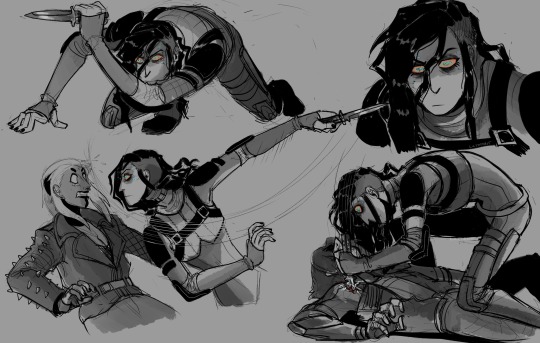
Had another session of Sprawl a couple nights ago.
For context, Kassidy has a chip in her head that allows the corp she works for (Manticorp) to hijack her and take control of her body to make her do jobs for them. (Which is insult to injury because if they just asked and paid her she’d still do it but this about taking away her autonomy) And the chip has consequences if she spills the details to anyone.
Needless to say, the work Manticorp is forcing her to do is overlapping with the party so she sucks it up and tells the them regardless of whatever pain it was gonna cause her… the chip immediately assumed control and made her watch as she's puppetted into was attacking the party. And Kass is unfortunately one of the two in the group who is built to deal damage. She was able to take control back just before she was about to kill the hacker, stabbing the shoulder instead of his heart.
Needless to say she's having a great time.
137 notes
·
View notes
Text
If you want as a bonus you can tell me about how you started in the tags when you reblog I love hearing peoples’ TTRPG stories :)
#ttrpg#dnd#d&d#pathfinder#powered by the apocalypse#I’m genuinely really curious and was like hey now I can find out!#I’ve been at it for 10+ years if anyone was curious
1K notes
·
View notes
Text
Starting my motw campaign: "Hey, it might be cool to add political intrigue to the magical underworld."
Now, over a year in: "These are the factions that control the former united states."
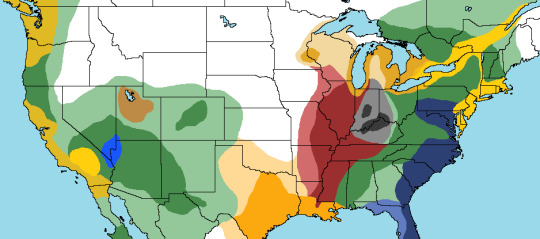
#motw campaign#motw ttrpg#motw rpg#motw#monster of the week#pbta#powered by the apocalypse#ttrpg#indie ttrpg#ttrpg community#rpg#ttrpg campaign#dnd#dnd campaign#alternate history#map#fantasy map#urban fantasy
256 notes
·
View notes
Text

@alizarinessence thank you for your patience as I took my time to respond to you!
PbtA games can be pretty daunting, and I certainly didn't understand how the play flow was supposed to work at first. I personally learned through trial and error, as well as watching other GMs who had figured it out - I am blessed to have a friend who is very experienced in running PbtA games so I was able to play in some of his games and ask him questions.
That being said, there have been a few things that I've also found helpful that I can refer to you, so I'm going to put them up here.
The Flow Chart

This flow chart was originally posted in a Dungeon World reddit post, and later referred to me when I started asking for PbtA advice. You'll likely see a similar flow chart in Apocalypse Keys, where Rae Nedjadi illustrates how a typical session of play is likely to look like.
In any given PbtA game, you as a GM are going to be presenting pieces of information to the players, just as you would in any other ttrpg. PbtA codifies this information as "moves," and each game will present you with information that is considered useful for the kind of story that it is design to tell.
In Masks, the players are teenage superheroes, so the game encourages the GM to introduce facts such as "civilians are in danger" or "your dad thinks you're being irresponsible."
In The Ward, the players are medical doctors in an Emergency Ward, so the game advises the GM to introduce truths such as "a patient's condition is worsening" or "someone's dad is fighting with a nurse in another room."
This reinforces the common maxim that the game is a conversation, a cycle of presenting new information, letting players decide what they want to do with that information, and making a roll if the fiction calls for it. This is a rather simplified cycle of course - the "see what happens" sections may include moments when players may jump in with their own characters' reactions, generating more events that the GM doesn't need to add to in order to make them interesting. Many PbtA games thrive off of player conflict, which can occupy the table for a couple of hours without the GM needing to add anything (Last Fleet is a good example of this kind of play.)
Listening to Others
Listening to other people play PbtA games can give you a sense of how the game is meant to feel, especially when the GM's and players take their time to talk through their moves and how they work.
I found Monster Hour to be exceptionally helpful; they started out as a Monster of the Week podcast, and even though I've never run MotW specifically, listening to Quinn talk the players through how to ask questions or use different moves made the game very easy for me to understand.
Joining a Community
Joining a community that loves a specific PbtA game, or PbtA games in general can be very helpful when seeking out advice. The PbtA Discord channel has a number of players and designers, who have a lot of game experience and are more than happy to dish out advice.
Start With Games That Have Guide-Rails
Not all PbtA games are created equal, and while the original spirit of the game was to make sure you didn't plot out a story-line, there's still some games that have a certain amount of prep that will give you the tools you need to gain confidence as a GM. Here's some of my favourites:
Visigoths vs. Mall Goths can be played as a one-shot, and doesn't require players to make a lot of decisions when putting their characters together. It has a number of scenarios that you can throw at your players, a mapped-out mall with details on all of the NPCs (and whether or not you can flirt with them), and some pretty hard limitations on what you can and cannot do. You can't leave the mall, for example - go through an exit on one side of the mall and you'll just pop back in on the other. You can visit the stores throughout the day, but each team of players can only go to so many places before the mall is closed for the day, therefore bringing the mission to a close.
Apocalypse Keys has a game structure that looks daunting but can be broken down into steps, and also comes with pre-written scenarios as well as instructions on how to create your own. The concept is pretty straightforward - you're solving a mystery, and you need to do it before one of the Doors of the Apocalypse is opened. This puts the game on a timer, which helps GMs keep their players on task, and also provides the Game Master with a list of clues to drop into the story as the players look for them. I've heard very good things about how Brindlewood Bay, which inspired some of the mechanics in Apocalypse Keys, makes itself easy to run for new GMs, so if you can get your hands on that book, you might find it helpful!
Last Fleet is laser-focused on a very specific premise - you are humans, in space, running away from a terrible and insidious threat. What is more, this threat has the ability to infiltrate your fleet. The laser-focus brings everyone at the table to the same page pretty quickly, and the setting includes a mounting pressure track that will make sure things keep happening, so as the person running the game, you won't have to do much after you set up the initial scenario. The game also comes with some really good advice on where you want to start with your players, to make sure they're on edge, but not fully panicking yet. Then you just need to tip the scales enough to cause them to ask questions, make questionable choices, and start a series of actions that snowball into catastrophe.
Wrapping Up
This is all the advice I have for stepping into PbtA, but more than anything, I recommend just diving in and giving it a go! As with any GM-ing endeavour, you will likely walk away from your first session with a list of things that you'll want to do differently the next time around, but that's just a sign that you're learning.
88 notes
·
View notes
Text
New level up option for all playbooks:
Gets jiggy with it
#rpg#roleplaying games#powered by the apocalypse#generic#character idea#advanced levels: stops being jiggy with it
264 notes
·
View notes
Text
We're so excited to have Meg and Vince Baker AND Rae Nedjadi (@temporalhiccup) together to talk Powered by the Apocalpyse for Splat 5!
101 notes
·
View notes
Text
So I'm reading Apocalypse World for the first time because I spent my early twenties being bored and stressed in grad school instead of learning cool games and I'm still catching up on the classics, and I was worried I would find it dated or uninteresting in the way that Pioneering Pieces of Media often are, I've played a lot of the kind of first generation of PbtA games but not AW itself, what if this is a Seinfeld Is Unfunny situation, etc
I should not have worried, this game is fucking charming. It's so, like--quirky? I mean that as a high point. It has that personality that you get in a game that really commits to its genre. Like your characters don't have like, "assets" or "inventory," they have "crap." That's great. I love that.
Also, THE PLAYBOOKS AREN'T IN LANDSCAPE?! What?! Are they only like that in the book and the printouts made them landscape? Or did a DIFFERENT PbtA game introduce the now-inescapable landscape format? I need to know! If you know, please tell me!
(Edit: I should specify that I'm reading 1st Ed, as far as I know)
64 notes
·
View notes
Text
Best Queer TTRPGS
Blue Rose is a long-time love of mine. From its understanding of gender to how it views relationships, this world is queer through and through. Blue Rose uses the AGE system and is well equipped for epic fantasy tales.
Girl By Moonlight: a relative newcomer on the scene, Girl By Moonlight was published earlier this year by Evil Hat Productions. The game actively encourages queer themes, such as the exploration of gender identity and triumph of love over an uncaring world (while not essentially queer, the latter theme is very relatable to many of us!)
Girl By Moonlight uses the Forged in the Dark system, which originated with the popular Blades in the Dark.
Thirsty Sword Lesbians is a by now famous ttrpg Powered by the Apocalypse. Thirsty is a celebration of queer culture, sometimes joyful, sometimes angsty, always engrossing. Its robust social mechanics make it an excellent alternative to dungeon crawlers for those looking for a roleplay heavy gaming experience.
Lichcraft is a rules-lite game about becoming an immortal lich to live long enough to receive gender-affirming healthcare from an increasingly long waitlist. The art is gorgeous and the game cathartic. Also, who doesn't love liches?
Queering Your Favourite Games
Queercoded for 5th edition Dungeons and Dragons.
Queerfinder for Pathfinder 2nd edition.,
Queerz for City of Mist.
Queer Actual Plays
High Rollers: a popular British Dungeons and Dragons actual play with a genderfluid DM, and multiple queer players. Their most recently completed campaign, Aerois, contained multiple queer characters and relationships.
Transplanar: an all trans, bipoc-led production. You may like to start with Godkiller: at sixteen episodes, it's the perfect length to get a feeling for this tale's vibe and storytelling style.
#girl by moonlight#forged in the dark#powered by the apocalypse#lichcraft#ttrpg#high rollers#transplanar#blue rose#thirsty sword lesbians#AGE rpg#dungeons and dragons#queercoded#queerfinder#queerz#dnd 5e
90 notes
·
View notes
Text
TTRPG Read-Through: Patchwork World
Here is a read-through I did last year (originally posted on Twitter) of one of the most unique PbtA games I've ever read: Patchwork World by Aaron King! - Christian
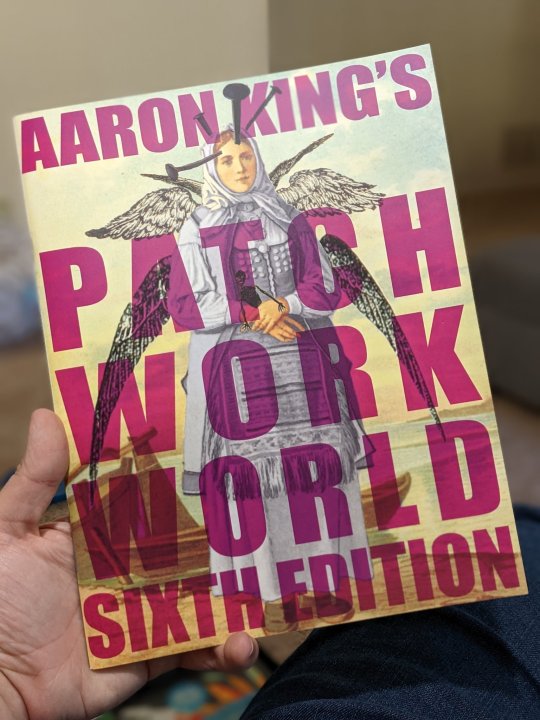
Credits up first. I know a lot of these folks and they are really cool! Excited to dig into this. I've heard good things, and it's been a while since I've read or played any Powered by the Apocalypse.
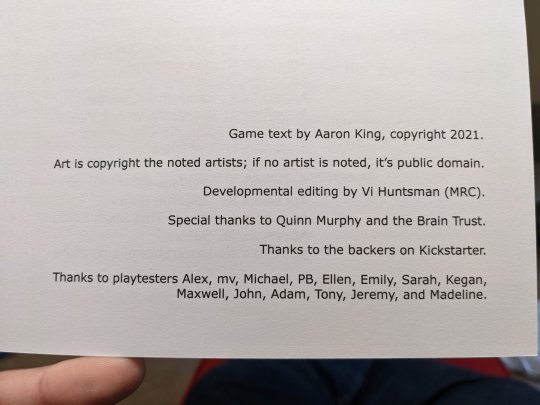
This is a cool, strong set up for me. I really like settings that ask characters to face a changing world and either take up change themselves or work to restore the old way of things. It's a headspace I find myself in a lot IRL these days so it's fun to explore.

I'm interested to see how the no stats, no playbooks angle of this game works, considering playbooks are typically such a staple of PbtA games.
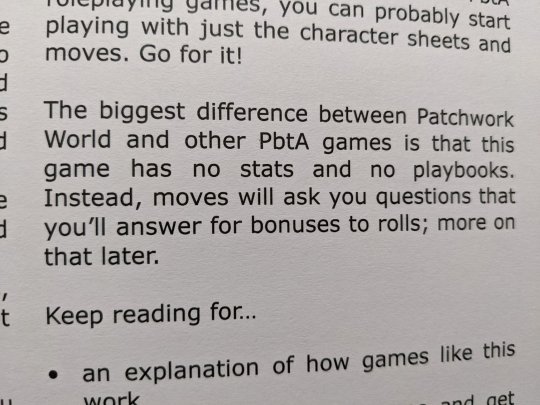
Standard three-tired success, mixed success, fail forward resolution for rolls here and questions on the moves determine your bonus to the roll. Easy peasy. +2 is the max bonus.

Other types of rolls are described here. Interested to see how they come into play. I also love clocks and use them in pretty much every game I run so it's nice to see those laid out here too.
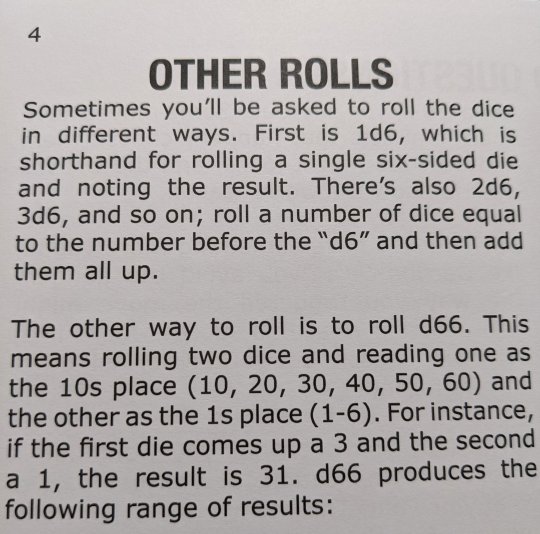
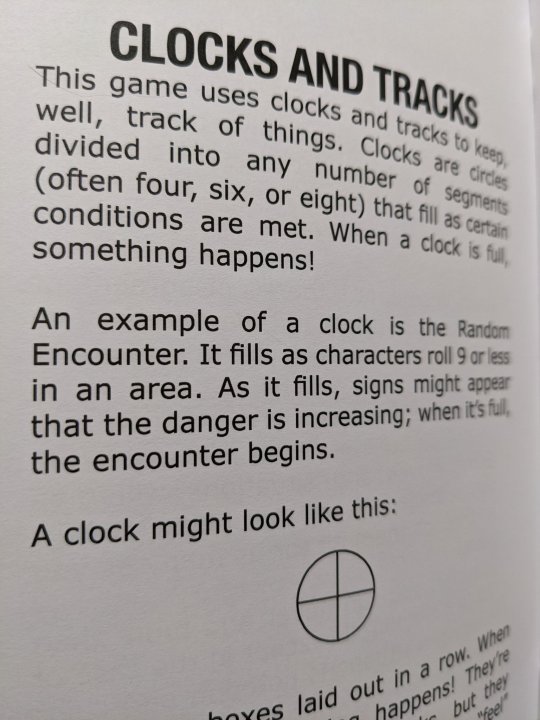
We just love a lil guy, don't we folks?
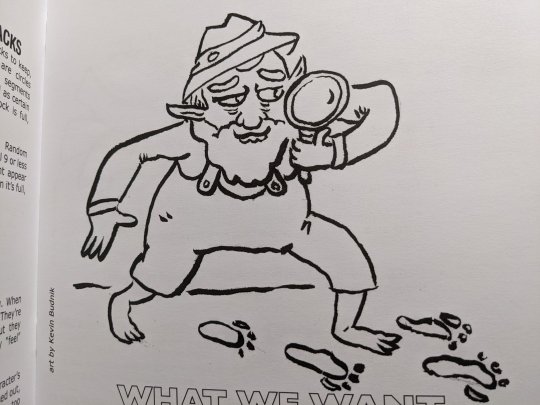
A good chunk of the opening here is spent on laying out a lot of solid foundations of roleplaying generally. It feels like a book (so far) that would work for entirely new players. It doesn't feel essential for me, but I never mind a game that supports varied experience levels.

Character creation is wide open, especially since there aren't playbooks and the text stresses that character creation is very much worldbuilding because of this. Fate-like concepts and tags are in here too which are things I generally enjoy. I like the Drawback mechanic.
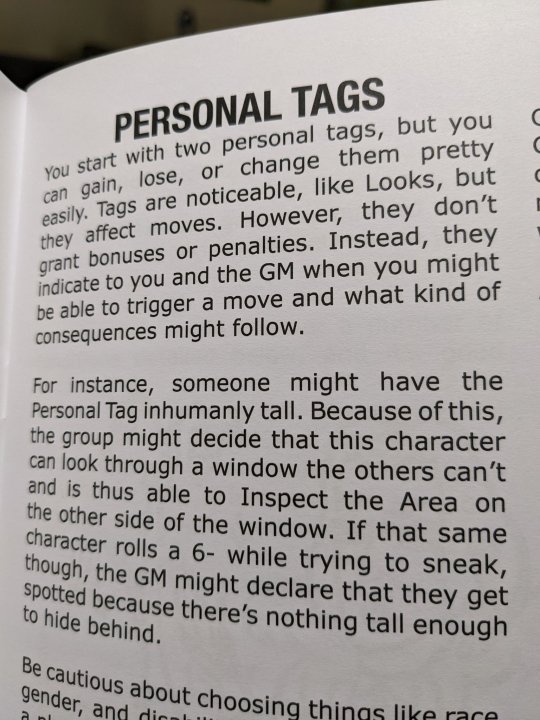
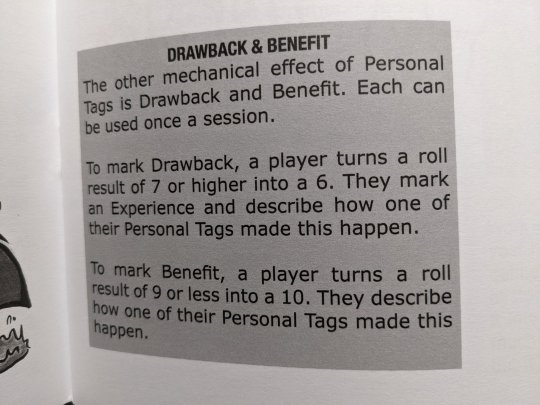
Moves are in the playback I set in the other room so I'm gonna go grab those. You get two chosen moves and everyone has access to a number of default moves. You've got three other life/XP things to keep track of too. I'm especially interested in Hex.

There are a lot of moves! They seem quite varied and often very weird, fitting well with the titular patchwork world. You can have a duck's slick soul to dodge more easily or a magical space suit or speak to birds or be good at cartography. Overwhelming, but in an exciting way.
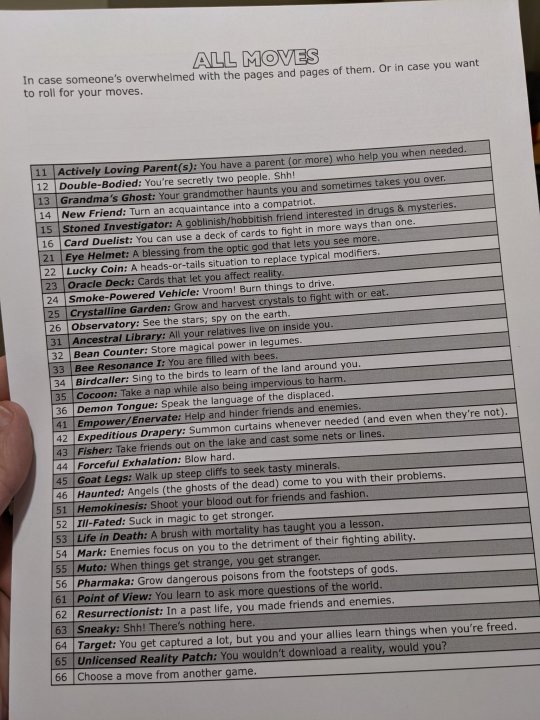
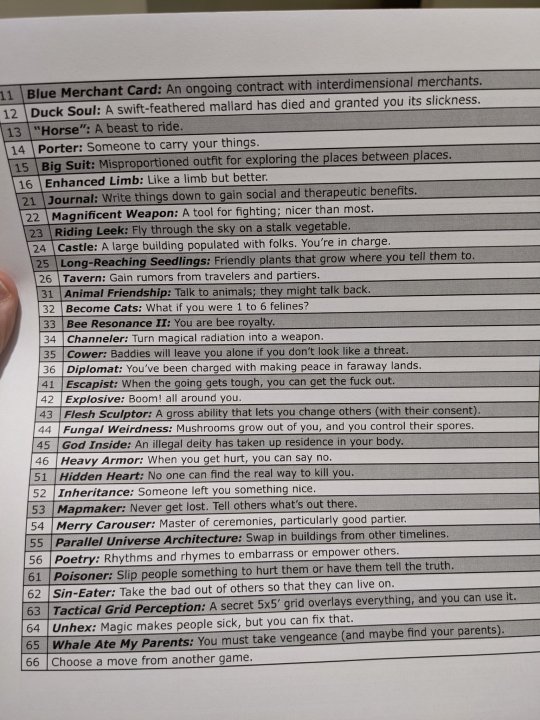
You also choose a community as a party. While PCs all have their original homelands (before the end of the old worlds), you know have a community that gets its own little sheet. This is a cool reshaping of the Gangs from Blades. I also like how the community can change over time.
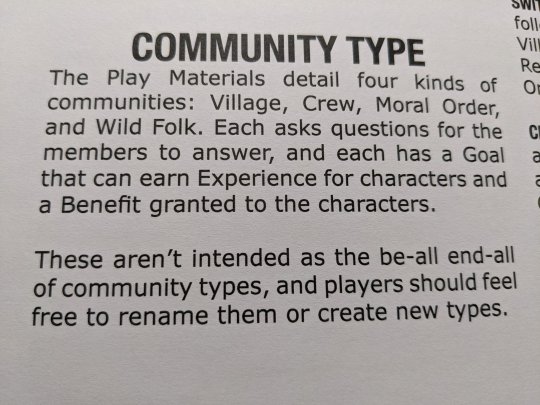
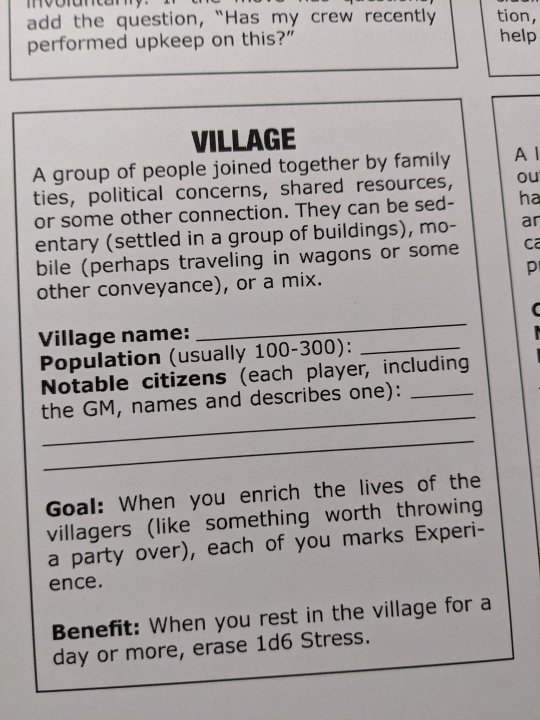
Coming back to a PbtA game after months of more OSR-minded stuff, I think a lot of what these games contain are things that experienced players would say you could just do in any game at any time that it makes sense in the story, but I do find value in stating what's possible.
Esp since many players come to games with artificial limits on their options (whether that's from video games, more traditional RPGs, etc.). I just think good GMing here requires making sure that the players don't limit themselves just to the bevy of explicit options either.
GM moves (mostly to guide the response to failed rolls). I really think the community aspect of this set up is one of the biggest appeals to me so far. That and the wild list of moves, which I'm sure makes for amazing parties of characters.

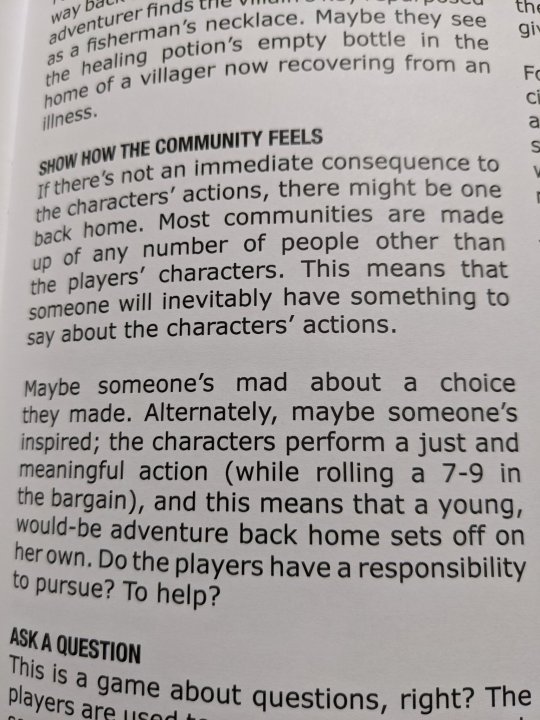
I always feel like it's never something I should be in my own writing (for some probably unnecessary reason), but I enjoy the first-person, casual writing style throughout the book. Makes for a very chill read.
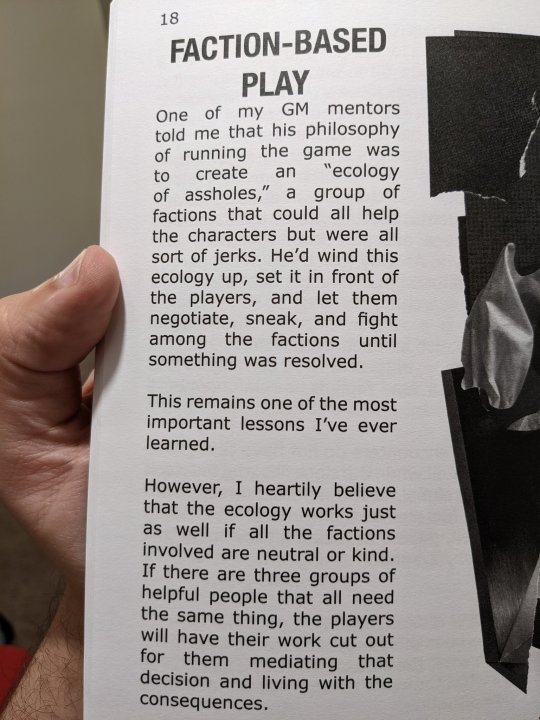
Good to see this game employs the Branson Reese style of NPC naming.

Stress acts as a single catch-all health and challenge rating for NPCs. Ideally, I'd hope this would help lead to the PCs approaching encounters with more than just violence.
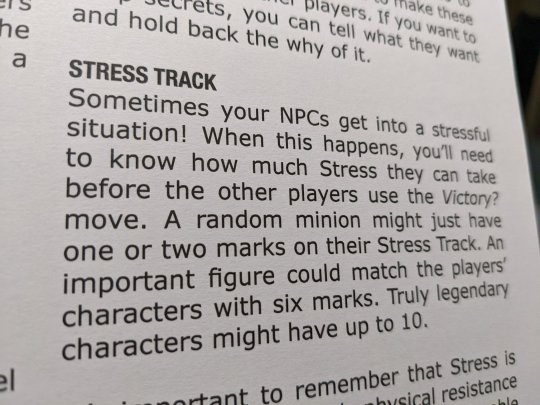
Sections like this are what I'm referring to when I say this book feels very friendly to new players. It's got little anecdotes and thoughts like this throughout.

Look, it's been a while since I've seen A Christmas Story but... it didn't have ghosts in it right?
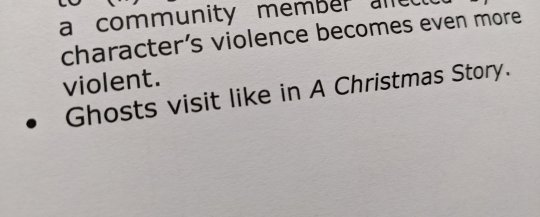
There's a sample adventure in the back (which I'll skip for this read-through) plus loads of random tables. Some wonderfully bizarre stuff in the characters and faction tables. Really gives you a good idea for how gonzo you can go with the setting.
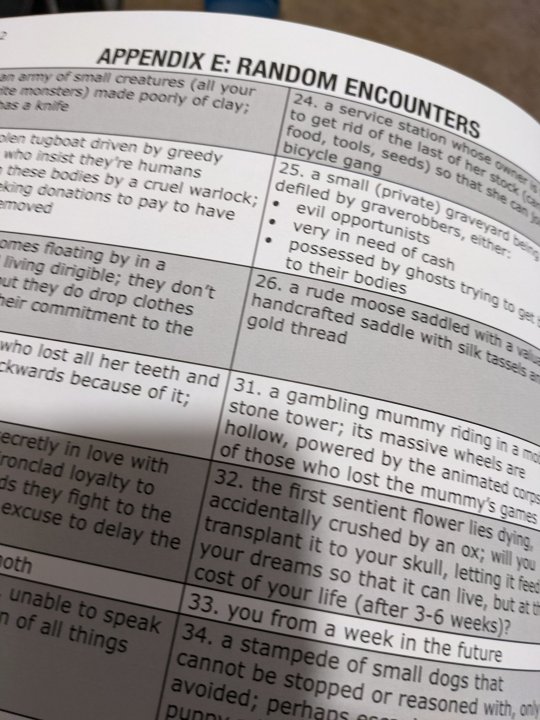
Love these two in particular

Optional rules include hard mode (which I just think is kind of funny to see in PbtA, but could be cool if you lean heavy into the post-apoc setting) and some optional moves. I like that some moves focus on romance, something I enjoy IRL but never think to focus on in games.
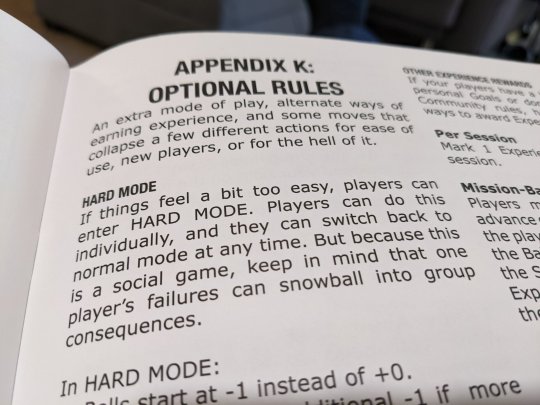
I was wondering why this was the sixth edition!

That's all for the book itself. Going back to the packet to dig into the things I missed. Some expected bits in here but always one or two unique options I really enjoy. Leaking hex is cool (and could have some troubling cascade effects in certain situations).
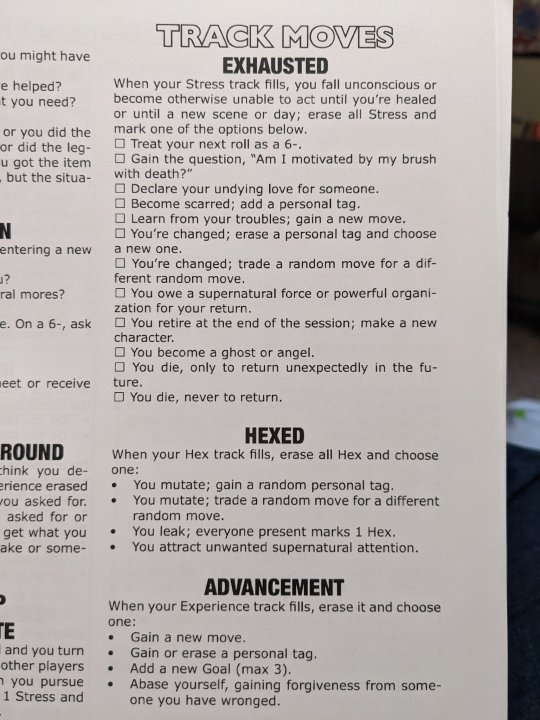
I definitely wish, at least in sitting down to read like this, that the contents of the player packet was also in the book itself. I think PbtA has this tendency of leading to loads of pages on the table, but it can make them very easy to pick up and play or to learn as you play.
That element is definitely here, but I think the vast number of wide-ranging moves and the excitement that would drum up in my player group would more than makeup for that initial overwhelming feel of "whoa, that's a lot of papers out on the table".
Overall, it's the most I've wanted to play a game in this style in a while. I like that the base setup for the world is very much up to the players to determine via the characters they make. I like that PCs here will probably feel unlike any other folks have played before.
The community aspect feels like where I'd want to center my story around, as a player. Seeing that shift and change over time feels like it would be very rewarding and would help lean into the "the old world is dead, what do we want the new world to look like?" theme I enjoy.
Because Aaron King is cool and recently hit a lot of Twitter followers, Patchwork Worlds is now Pay-what-you-want over on Itch.
I'm not sure if physical copies are readily available. For full disclosure (guess I should have said this up front), I got this copy for free from Aaron! Not for the purposes of this thread or anything, just for fun a while back.
Thanks for reading more ramblings from me! If you like to do that sort of thing, check out my newsletter - Missives from the MeatCastle. It's got writings on my work, cool stuff I've run across the web in the last month, and exclusive rpg stuff! https://meatcastle.substack.com
#indie ttrpg#ttrpg#ttrpgs#rpg#fantasy#science fiction#pbta#powered by the apocalypse#aaron king#patchworld world#sixth edition#read through
105 notes
·
View notes
Text
Round 1: Hellen Highwater vs Chronos Goodman, Time Attorney at Law


Image ID included, click to see the full image please!
More about each NPC below the cut!
Character 1
Name: Hellen Highwater
Party: Team Kill
Relationship to party: A party member's girlfriend, a party member
What makes them the best NPC:
She's very silly and makes so many puns, she's a dragonblood sorcerer whose dad is a copper dragon. For most of her life she could spit acid and thought it was just because of the specific ancestry she had and had no clue it could have been related to her copper-y scales. She was the first person to really get to know the party's resident edgy man. Originally she was supposed to be a minor part of the plot, sending the party letters from her home, but the party and the DM liked her so much she managed to stay in the party.
Any extra propaganda under the tag Hellen Highwater, to be found here
_ _ _ _ _ _ _ _ _ _ _ _ _ _ _ _ _ _ _ _
Character 2
Name: Chronos Goodman, Time Attorney At Law
Party: Pandeia Boys Nite
Relationship to party: The party's legal aid after our psychic was caught breaking the time-space continuum
What makes them the best NPC:
He is an unfathomably powerful time walker with unknown power who opted to help 3 gay men beat the temporal anomaly allegations. He also wears a white dragon scale suit and generally fucks severely. Yes he is corrupt but he is corrupt for us <3
Any extra propaganda under the tag Chronos Goodman, to be found here
#round 1#polls#dungeons and dragons#d&d#dnd#dnd oc#dnd npc#ttrpg#pathfinder#powered by the apocalypse#dnd stuff#dnd character#character tournament#oc tournament#homebrew#dnd homebrew#d&d 5e#d&d 5e homebrew
161 notes
·
View notes
Text
Have you played THIRSTY SWORD LESBIANS ?
By April Kit Walsh
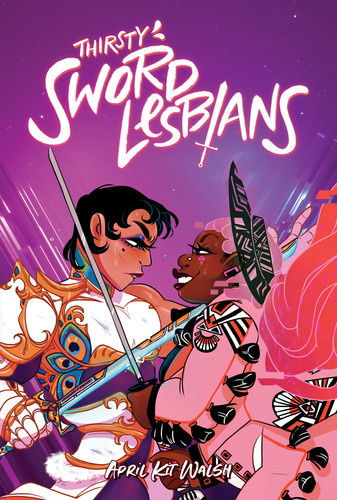
Thirsty Sword Lesbians battle the Lady of Chains when her enforcers march down from the frosty north. They rocket through the stars to safeguard diplomats ending a generations-old conflict. Even when swords are crossed, they seek peace with their opponent—and sometimes connect more deeply than anyone expects.
A sword duel can end in kissing, a witch can gain her power by helping others find love, and an entire campaign can be built around wandering matchmakers flying from system to system.
Thirsty Sword Lesbians is a roleplaying game for telling queer stories with friends. If you love angsty disaster lesbians with swords, you have come to the right place.
140 notes
·
View notes
Text
Alternative systems to publish your TTRPG content under now that WotC is promising to steal your stuff if you make it with D&D:
Cypher System by Monte Cook Games:
Apocalypse World/Powered by the Apocalypse:
Blades in the Dark:
Modiphius (2d20 system):
I know there are many more, but those are the big systems that pop in my head at the moment. (Technically, GURPS also lives in my head, but that's more of a curse, really.)
Go make your cool stuff and don't let anyone tell you it isn't yours just because you used their game rules.
#ttrpg#roleplaying games#ttrpg community#ogl 1.1#wizards of the coast#wotc#cypher system#monte cook games#apocalypse world#powered by the apocalypse#pbta#blades in the dark#forged in the dark#modiphius#2d20 system#d&d
581 notes
·
View notes
Text
Discover who you were. Decide who you are. DETECT OR DIE

Do you like mysteries? Do you want to experience a mystery tabletop game unlike any other you've ever encountered? Did you play Disco Elysium and think "But what if ... my friends and I could be that guy, together?" I have a game for you!
In DETECT OR DIE, each player takes on the role of a part of an amnesiac detective's fragmented mind. Together, you investigate the all-important Case and the Detective's own past. Discover who you were. Decide who you are. DETECT OR DIE on sale now!
Don't forget it's itch.io creator's day, so don't wait, TODAY is the day!
A game by the incomparable Ben Klug, edited by me, cover design by Boocanan
#tabletop#tabletop games#ttrpg#indie ttrpg#ttrpgs#trpg#tabletop rpg#tabletop roleplaying#disco elysium#powered by the apocalypse#pbta
109 notes
·
View notes